In this paper, we study detectors that can be potentially used to discover the radio signals that control the roadside bombs. The most important issue in this paper is that the study takes into consideration the noise power fluctuation with relatively variable signal to noise ratio. We examine two types of detectors in this paper the energy detection and matched filter and this paper propose a modified number of samples to detect the wireless controlled roadside bombs.
Keywords |
| Cognitive Radio; Responsive Communication Jamming; Noise Power Fluctuation |
INTRODUCTION |
| Cognitive radio networks (CR) are one of the enabling technologies for future communication and networking [1]. CR
networks have been developed for improving and optimizing the radio electromagnetic spectrum, by combining two
main characteristics: cognitive capabilities and reconfigurability. The former is achieved by combining radio-scene
analysis and predictive channel-state estimation, while the latter is provided by a platform known as software-defined
radio upon which a cognitive radio is built on [2]. |
| Devices used in roadside improvised explosive have become one of the most important threats in today’s asymmetric
warfare and terrorist activities. These devices are inexpensive, easy to build or acquire, and difficult to trace and can be
triggered from any detonation or exposure to targeted military forces. In many cases these device contain explosive
material that is integrated with handheld wireless radio or device that will trigger upon receipt of a signal from a second
wireless handheld device [3]. |
| Vehicle-mounted barrage jammers have been in operation for some time [4]. These jamming systems continuously jam
relevant frequency bands as a precaution against these wireless-enabled bombs irrespective of actual signal activities
[5]. |
RELATED WORK |
| The concept of responsive communication jamming has been proposed to deal with the roadside improvised explosive
devices. Responsive jamming is related to cognitive radio behaviour. The responsive jammer attempts to sense the
bomb control signals and react by jamming it [6]. It is very important to both cognitive radio and responsive
communication jamming is to get fast and reliable spectrum sensing. As the responsive communication jamming
system is responsive for human lives we want the probability of missed detection to be as small as possible. |
| In this paper we will investigate the number of samples that are necessary to reach a given probability of missed
detection and probability of false alarm with varying noise power level. The detectors considered are energy detector,
and matched filter. |
| Most detection especially energy detectors are based on constant noise power [7-9], also same papers research on nonconstant
noise power [10-15] while the number of samples calculated in [16] is 338 for energy detection and 91 for
matched filter. |
PROPOSED ALGORITHM |
| The problem of signal detection in additive Gaussian noise can be formulated as a binary hypothesis testing problem
with the following hypotheses: |
 |
| Where Y(n), X(n) and W(n) are the received signals at CR nodes, transmitted signals at primary nodes and white noise
samples, respectively; H1 and H0 stand for the decision that the licensed user is present or not, respectively. Noise
samples W(n) are from additive white Gaussian noise process with power spectral density σ2 , i.e. W(n) �� N (0, σ2)
[9]. |
Energy Detector |
| The performance of matched filter would serve the limit of possibility [17]. |
 |
| Under both hypotheses the test statistic is normally distributed. The probability of false alarm is |
 |
| Where Q(·) is the standard Gaussian complementary cumulative distribution function (CDF) and P = Σ |X(n)|2/N is the average signal power, σ2 is the noise variance. |
| And the probability of detection is |
 |
| To simplify the problem, energy detection algorithm based on average noise power without uncertainty has been
discussed. United (3) and (4) eliminate the variable of decision threshold γ, and we can get: |
 |
| Where Q−1 is the inverse standard Gaussian complementary cumulative distribution function (CDF), SNR = P/ σ2 is the
signal-to-noise ratio. |
| Figure 1 is the numerical results of equation (5), the simulation parameters are: SNR= 0 dB, pf (0, 0.5), and N ∈ {5,
10, 20, 50, 100}. |
| Figure 1 and the previous equations considered only the case without noise uncertainty. Now, consider the case with
uncertainty in the noise model. The variance of noise with uncertainty can be included in a signal interval σ2n ∈ [ σ2n /β,
βσ2n ]. Where β ≥ 1 is the noise fluctuation factor. |
| Equation (3) and (4) will be |
 |
 |
| Equations (6) and (7) show that if β=1 then the equations will tend to equation (3) and (4), If β increased with low SNR
the required number of samples to get the same Pd and Pf must be increased. Also the previous equations show that if
we assume 10-6 probability of false detection and 10-6 probability of missed detection (pmd = 1 − pd ) i.e., 0.999999
detection probability, then we need N=338 without considering noise fluctuation and this value increased to 344 with
noise uncertainty of 1.05, and 415 for noise uncertainty of 1.1. |
| Figure 2 shows the receiver operating characteristics for energy detection with noise uncertainty β=1.05. And figure 3
compare between the ROC of energy detection without and with noise uncertainty for N=5, 20 and N=50. The figure
shows that noise power uncertainty has a passive impact on the ROC especially with the small number of samples N. |
| Figures 4 and 5 are the numerical results of equations (5), (6) and (7), the simulation parameters are: SNR∈ (0 dB, -
30dB), Pf ∈ (0, 0.5), and N = 20, and β=1.05. While figure 4 shows the effect of SNR on Pd and Pf for energy detection
system, figure 5 shows the effect of noise power fluctuation with different SNR and their effect on both of Pd and Pf.
Figure 5 shows that decreasing SNR or increasing the noise fluctuation factor will decrease the probability of detection
specially for communication jamming detector that required small number of samples to be able to get fast detection. |
Matched Filter |
| The matched filter is optimal detector of signals in white Gaussian noise. The drawback being that the detector needs a
large amount of information about the signal it attempts to detect. Most likely we do not have all this information;
however, the performance of matched filter would serve the limit of possibility. |
 |
| Under both hypotheses the test statistic is normally distributed. The probability of false alarm is |
 |
| And the probability of detection is |
 |
| To simplify the problem, matched filter detection algorithm based on average noise power without uncertainty has been
discussed. United (9) and (10) eliminate the variable of decision threshold γ, and we can get: |
 |
| ROC for matched filter is shown in Figure 3 with the following numerical values: SNR=0 dB, false alarm probability Pf
∈ (0, 0.5). |
| Figure 6 and equations (9), (10), and (11) considered only the case without noise uncertainty for matched filter. Now,
consider the case with uncertainty in the noise model, equations (9) and (10) will be |
 |
 |
| Eliminating γ we can get |
 |
| Equation (14) shows that if β=1 then the equation will tend to equation (11) and if β increased it slightly effect the
required number of samples. Moreover equation (14) shows that if the probability of false detection is 10-6 and 10-6
probability of missed detection, then we need N=91 without considering noise fluctuation and this value increased to 95
with noise uncertainty of 1.5. |
| Figure 8 is the numerical result of equation (14), the simulation parameters are: Pf ∈ (0, 0.5), β=1.05 and N ∈ {5, 10,
20, 50, 100}. The figure shows that noise uncertainty has a small effect on the required number of detection sample.
Comparing figures 1, 2, 6, and 7 show that the effect of noise uncertainty has much more effect in energy detection and
can decrease the detection probability on the same number of detection samples. |
| Figures 9 and 10 are the numerical results of equations (11) and (14), the simulation parameters are: SNR∈ (0 dB, -
30dB), Pf ∈ (0, 0.5), and N = 20, and β=1.05. While figure 9 shows the effect of SNR on Pd and Pf for matched filter,
figure 10 shows the effect of noise power fluctuation with different SNR and their effect on both of Pd and Pf. |
CONCLUSION AND FUTURE WORK |
| The results illustrate that energy detector is very sensitive to noise fluctuation and the minimum number of samples
required to get certain missed probability increased with small fluctuation in noise. Meanwhile matched filter required
sever fluctuation in noise to affect the required number of samples. |
| Previous works showed that the ideal number of samples for energy detector to get 10-6 missed probability is 338 and
this work recommends 415 samples to avoid 10% noise fluctuation effect. This values is 91 sample for matched filter
increased to 95 with 1.5 noise fluctuation factor. |
| This paper has verified that the performance decreased under noise uncertainty environments. This show that the choice
of a fixed sample number is no longer valid under noise uncertainty and this should be chosen flexible as necessary.
This work can be extended to Feature detector and Eigenvalue detector. |
| |
Figures at a glance |
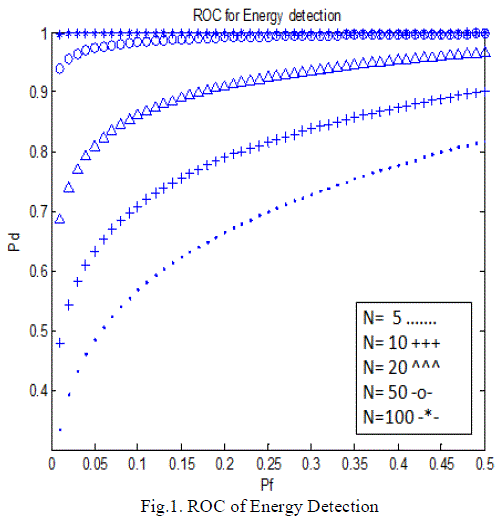 |
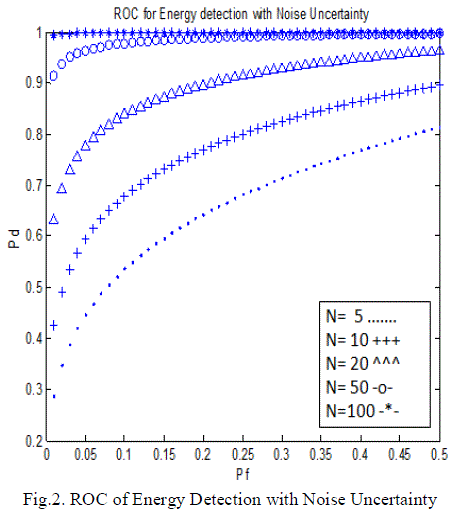 |
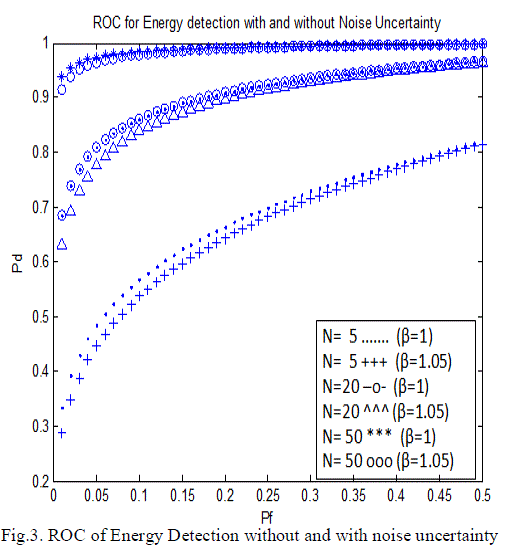 |
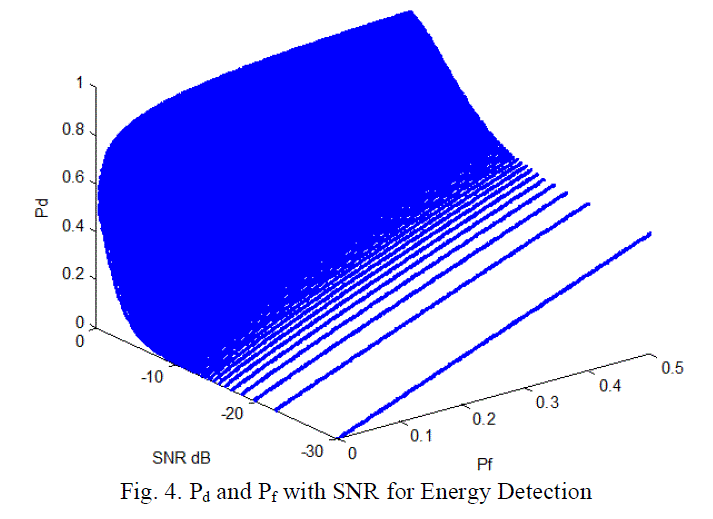 |
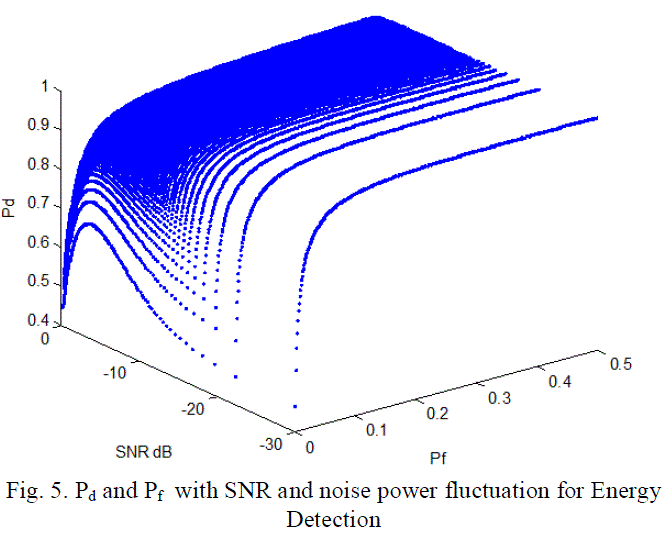 |
| Figure 1 |
Figure 2 |
Figure 3 |
Figure 4 |
Figure 5 |
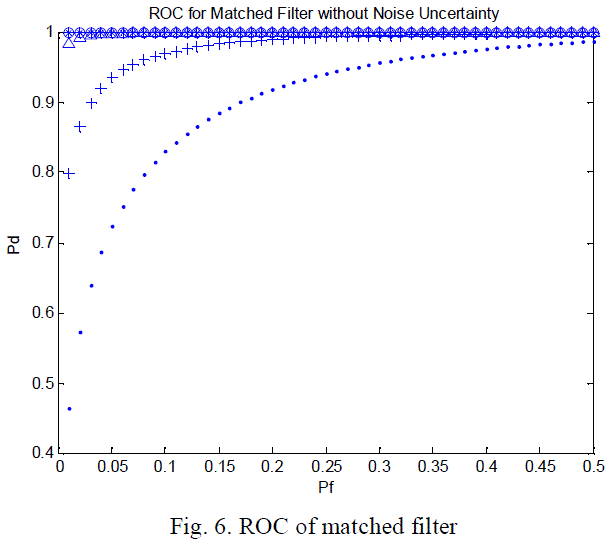 |
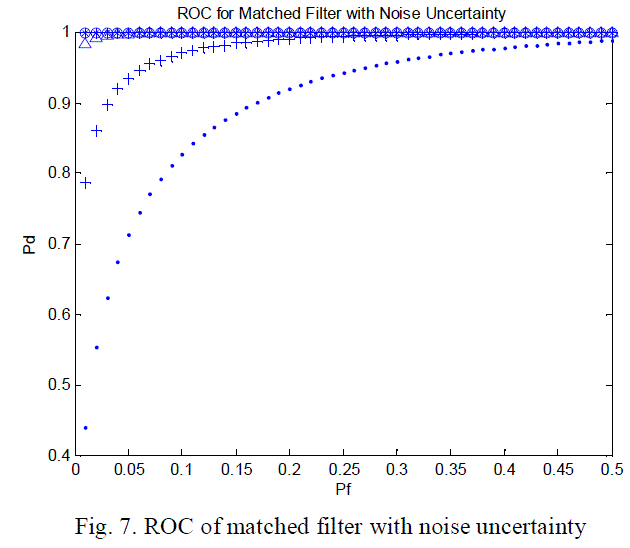 |
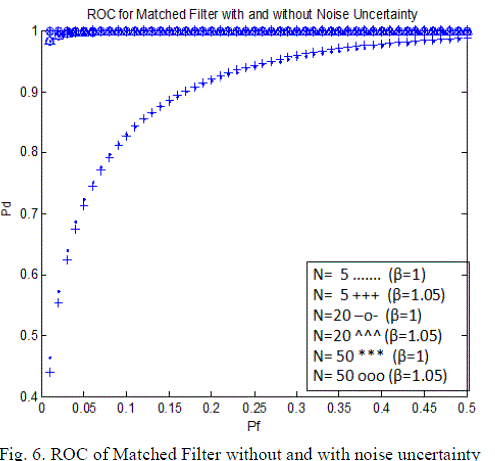 |
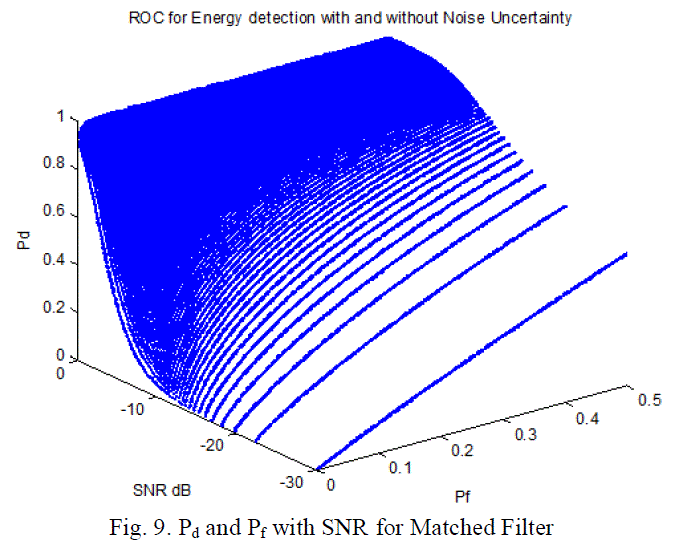 |
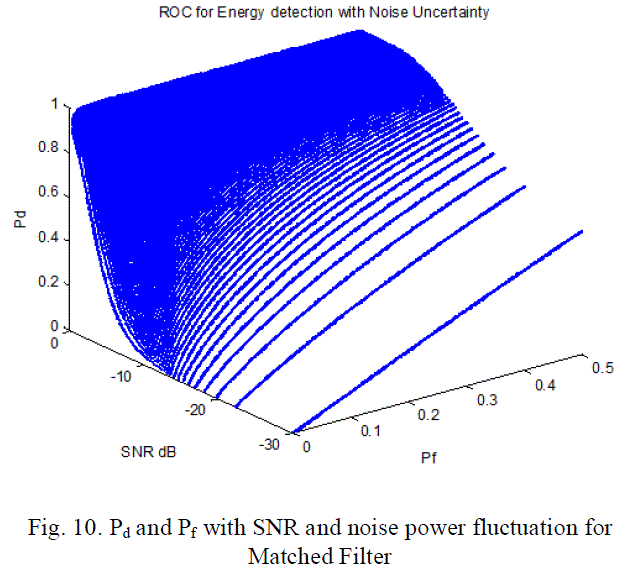 |
| Figure 6 |
Figure 7 |
Figure 8 |
Figure 9 |
Figure 10 |
|
| |
References |
- F. Akyildiz, W.-Y. Lee, M. C. Vuran, and S. Mohanty, ?Next generation/dynamic spectrum access/cognitive radio wireless networks: a survey,? Computer Network, vol. 50, no. 13, pp. 2127?2159, Sept. 2006
- R. Pietro, G. Oligeri, ?Jamming Mitigation in Cognitive Radio Networks?, IEEE Network Magazine, Vol.27, No.3, May-June 2013.
- M. C. Pesci, ?System engineering in Counter Radio-Controlled improvised Explosive Device Electronic Warfare,? Johns Hopkins APL Technical Digest, Vol. 31, No.1, 2012.
- D. Eshel, ?Defeating IEDs,? AOC J. Electronic Defense (JED), vol. 30, no. 12, pp. 38?42, Dec. 2007.
- P. Loos, J. Mietzner, P. Nickel, G. Bauch, and A. Meusling, ?Design of a Multitone Firefly Time Synchronization Scheme for Responsive Vehicle-Protection Jammers?, in Proc. Military Communication Conference (MILCOM 2012), Orlando, Florida, USA, Oct./Nov. 2012.
- S. Haykin, D. Thompson, and J. Reed, ?Spectrum sensing for cognitive radio,? Proc. IEEE, vol. 97, pp. 849-877, May 2009.
- S. M. Mishra, A. Sahai, and R. W. Broderson, ?Cooperative sensing among cognitive radios?. In Proc. ICC 2005, Istanbul, Turkey, Jun. 11C15, 2006.
- F. A Ian, Y. L Won, C. V Mehmet, et al, ?A Survey on Spectrum Management in Cognitive Radio Networks?. IEEE Communications Magazine, Volume 46, Issue 4, pp: 40-48, April 2008.
- D. Cabric, A. Tkachenko, R. W. Brodersen, ?Experimental study of spectrum sensing based on energy detection and netwotk cooperation?. In ACM Int. Workshop on Technology and Policy for Accessing Spectrum. Boston, USA, 2006.
- G. Yu, C. Long, M. Xiang, W. Xi, ?A Novel Energy Detection Scheme Based on Dynamic Threshold in Cognitive Radio Systems.? Journal of Computational Information Systems 8: 6, 2245-2252, 2012.
- G. C., YU, Y. B., SHAO, G. X, YUE, et al, ?Dynamic Threshold Based Spectrum Detection in Cognitive Radio Systems?, 5th IntConference on Wireless Communications, Networking and Mobile Computing, WiCOM 2009.
- G. C., ?Detection Sensitivity Based on Energy Detection in Cognitive Radio Systems?, 3rd International Conference on Computer and Network Technology, pp: 575 ? 578, 2011.
- G. C., YU, A. LI, ?Research on Dynamic Threshold Based Energy Detection in Cognitive Radio Systems?, 2011 3rd International Conference on Computer and Network Technology, pp: 450 ? 453.
- R. YANG, Y. B LI, F. YE, ?The Spectrum Access Algorithm with Spectrum Sensing Overhead in Cognitive Radio Networks?, Vol. 7, pp: 4121 ? 4128, 2011.
- G. C., YU, T. LUO, G. X, YUE, ?Energy Detection Algorithm Investigation Based on Cooperative in Cognitive Radio Systems?, Journal of Electronics & Information Technology, Vol. 31, No. 11, pp: 2682-2686, Nov. 2009.
- T. Trump, I. Müürsepp, ?Detection Speed of Responsive Communication Jamming Detectors.? 2nd International Conference on Circuits,Systems, Communications, Computers and Applications, Dubrovnik, Croatia June 25-27, 2013.
- Z. Quan, H.V. Poor, and A.H. Sayed, ?Collaborative wideband sensing for cognitive radios,? IEEE Signal Processing Magazine, vol. 25, pp. 60?73, Nov. 2008.
|